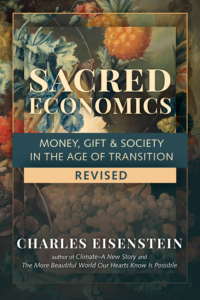Climate — A New Story
Chapters
Bibliography
Ahmed, Shariqua. (2015). “How Rajendra Singh AKA ‘Waterman of India’ Solved Rural Rajasthan’s Freshwater Crisis.” www.dogonews.com/2015/10/22/how-rajendra-singh-aka-waterman-of-india-solved-rural-rajasthans-freshwater-crisis.
Albert, Bruce, et al. (2014). “Rescuing US Biomedical Research from Its Systemic Flaws.” Proceedings of the National Academy of Sciences 111, no. 16 (March 18).
Alley, R. B. (2000). “The Younger Dryas Cold Interval as Viewed from Central Greenland.” Quaternary Science Reviews 19.
Anderson, Kat. (2006). Tending the Wild: Native American Knowledge and the Management of California’s Natural Resources. Oakland, CA: University of California Press.
Andrich, M. A., and J. Imberger. (2013). “The Effect of Land Clearing on Rainfall and Fresh Water Resources in Western Australia: A Multi-functional Sustainability Analysis.” International Journal of Sustainable Development & World Ecology 20, no. 6.
Angelini, I. M., M. Garstang, R. E. Davis, et al. (2011). “On the Coupling between Vegetation and the Atmosphere.” Theoretical and Applied Climatology 105 (August): 243. doi:10.1007/s00704-010-0377-5.
Apfelbaum, Steve. (1993). “The Role of Landscapes in Stormwater Management.” Applied Ecological Services. www.researchgate.net/publication/254840834_The_Role_of_Landscapes_in_Stormwater_Management.
Apffel-Marglin, Frédérique. (2012). Subversive Spiritualities. New York: Oxford University Press.
Arneth, A., et al. (2017). “Historical Carbon Dioxide Emissions Caused by Land-Use Changes Are Possibly Larger Than Assumed.” Nature Geoscience 10: 79–84.
Baccini, A., et al. (2012). “Estimated Carbon Dioxide Emissions from Tropical Deforestation Improved by Carbon-Density Maps.” Nature Climate Change 2: 182–85. doi:10.1038/nclimate1354.
Baccini, A., et al. (2017). “Tropical Forests Are a Net Carbon Source based on Aboveground Measurements of Gain and Loss.” Science, September 28: eaam5962. doi:10.1126/science.aam5962.
Baker, Monya. (2016). “1,500 Scientists Lift the Lid on Reproducibility.” Nature, May 25.
Barnosky, Anthony D., et al. (2016). “Variable Impact of Late-Quaternary Megafaunal Extinction in Causing Ecological State Shifts in North and South America.” Proceedings of the National Academy of Sciences of the United States of America 113, no. 4: 856–61.
Belluz, Julia, and Steven Hoffman. (2015). “Science Is Often Flawed: It’s Time We Embraced That.” Vox, May 13. www.vox.com/2015/5/13/8591837/how-science-is-broken.
Biodiversity for a Livable Climate. (2017). Compendium of Scientific and Practical Findings Supporting Eco-Restoration to Address Global Warming 1, no. 1 ( July). https://bio4climate.org/wp-content/uploads/Compendium-Vol-1-No-1-July-2017-Biodiversity-for-a-Livable-Climate-1.pdf.
Blocker, Jack. (2014). “Horrifying Machine Eats Entire Trees in Seconds.” Metro News UK, June 28.
Bonan, G. B. (2008). “Forests and Climate Change: Forcings, Feedbacks, and the Cli- mate Benefits of Forests.” Science 320: 1444–49.
Buhner, Stephen Harrod. (2002). The Lost Language of Plants. White River Junction, VT: Chelsea Green.
Burtt, E. A. (1925). The Metaphysical Foundations of Modern Science. Reprinted by Dover Publications, 2003.
Carrington, Damian. (2016). “Global ‘Greening’ Has Slowed Rise of CO2 in the Atmosphere, Study Finds.” The Guardian, November 8.
Christensen, V., et al. (2014). “A Century of Fish Biomass Decline in the Ocean.”
Marine Ecology Progress Series 512, no. 1: 155–66.
Clay, Jason W., and Bonnie K. Holcomb. (1985). “The Politics of Famine in Ethiopia.”
Cultural Survival, June.
Community Cloud Forest Conservation. (2018). “Deforestation in Guatemala: Tracking by Decade.” http://cloudforestconservation.org/knowledge/cloud-forest/deforestation/.
Cooperafloresta. (2016). “Pesquisas ajudam a comprovar benefícios das agroflorestas.” Divulgador de Noticias, August 6.
Courcoux, Gaëlle. (2009). “Decline in Rainfall in the Amazon Basin.” Institut de recherche pour le développement Scientific Newssheets, December. Translated by Nicholas Flay. https://en.ird.fr/the-media-centre/scientific-newssheets/336-decline-in-rainfall-in-the-amazon-basin.
Crist, Eileen. (2007). “Beyond the Climate Crisis: A Critique of Climate Change Dis- course.” Telos 4 (Winter): 29–55. www.umweltethik.at/wp/wp-content/uploads/CristBeyondTheClimateCrisis.pdf.
Crowther, T. W., et al. (2015). “Mapping Tree Density at a Global Scale.” Nature 525 (September 10): 201–5.
Curry, Judith. (2016). “The Paradox of the Climate Change Consensus.” Climate Etc., April 17. https://judithcurry.com/2016/04/17/the-paradox-of-the-climate-change-consensus/#more-21437.
Daniels, Mitch. (2017). “Avoiding GMOs Is Not Only Unscientific, It Is Immoral.” Washington Post, December 27.
Davidson, N. C. (2014). “How Much Wetland Has the World Lost? Long-Term and Recent Trends in Global Wetland Area.” Marine and Freshwater Research 65, no. 10: 934–41. doi:10.1071/MF14173.
Dear, J., et al. (2013). “Life and Debt: Global Studies of Debt Resistance.” Jubilee Debt Campaign, October.
Demenge, Jonathan. (2018). “Measuring Ecological Footprints of Subsistence Farmers in Ladakh.” Institute of Development Studies.
DeRamus, H. A., et al. (2003). “Methane Emissions of Beef Cattle on Forages: Efficiency of Grazing Management Systems.” Journal of Environmental Quality 32, no. 1 ( January–February). doi:10.2134/jeq2003.2690.
Desmond, Matthew. (2017). Evicted: Poverty and Profit in the American City. New York: Broadway Books.
Dewar, W. K., et al. (2006). “Does the Marine Biosphere Mix the Ocean?” Journal of Marine Research 64: 541–61.
Diamond, Jared. (2005). Collapse: How Societies Choose to Fail or Succeed. New York: Viking Press.
Doughty, C. E., et al. (2016). “Global Nutrient Transport in a World of Giants.” Proceedings of the National Academy of Sciences 113, no. 4 ( January 26): 868–73.
Doughty, Christopher E., Adam Wolf, and Yadvinder Malhi. (2013). “The Legacy of the Pleistocene Megafauna Extinction on Nutrient Availability in Amazonia.” Nature Geoscience 6: 761–64. doi:10.1038/ngeo1895.
Duarte, C. M., T. Sintes, and N. Marbà. (2013). “Assessing the CO2 Capture Potential of Seagrass Restoration Projects.” Journal of Applied Ecology 50: 1341–49. doi:10.1111/1365-2664.12155.
The Economist. (2013). “Trouble at the Lab.” The Economist, October 18.
Eisenstein, Charles. (2014). “The Waters of Heterodoxy.” November 1. https:// charleseisenstein.net/essays/the-waters-of-heterodoxy-g-pollacks-the-fourth-phase-of-water/.
———. (2015a). “Aluna: A Message to Little Brother.” Tikkun, May 26.
———. (2015b). “‘Don’t Owe. Won’t Pay.’ Everything You’ve Been Told about Debt Is Wrong.” YES! magazine, August 20.
———. (2018). “Opposition to GMOs Is Neither Unscientific Nor Immoral.” January 9. https://charleseisenstein.net/essays/opposition-to-gmos/.
Ellison, D., et al. (2017). “Trees, Forests and Water: Cool Insights for a Hot World.”
Global Environmental Change 43.
Fears, Darryl. (2013). “Study Says U.S. Can’t Keep Up with Loss of Wetland.” Washington Post, December 8.
Ferroni, Ferruccio, and Robert J. Hopkirk. (2016). “Energy Return on Energy Invested (ERoEI) for Photovoltaic Solar Systems in Regions of Moderate Insola- tion.” Energy Policy 94: 336–44.
Food and Agriculture Organization of the United Nations. (2009). “Pastoralists— Playing a Critical Role in Managing Grasslands for Climate Change Mitigation and Adaptation.” www.fao.org/fileadmin/templates/agphome/documents/climate/Grasslands_Brief_final.pdf.
———. (2010). Global Forest Resources Assessment 2010. FAO Forestry Paper 163.
Foster, Grant. (2016). “Which Satellite Data?” Open Mind, November 27. https:// tamino.wordpress.com/2016/11/27/which-satellite-data/.
Freedman, David H. (2010). “Lies, Damned Lies, and Medical Science.” The Atlantic.
Gordon, Robert. (2012). “Is U.S. Economic Growth Over? Faltering Innovation Con- fronts the Six Headwinds.” NBER Working Paper No. 18315. National Bureau of Economic Research, August. doi:10.3386/w18315.
Gorshkov, V. G., and A. M. Makarieva. (2006). “Biotic Pump of Atmospheric Moisture as Driver of the Hydrological Cycle on Land.” Hydrology and Earth System Sciences Discussions 3.
Hallmann, C. A., et al. (2017). “More Than 75 Percent Decline over 27 Years in Total Flying Insect Biomass in Protected Areas.” PLoS ONE 12, no. 10: e0185809. doi:10.1371/journal.pone.0185809.
Hance, Jeremy. (2012). “New Meteorological Theory Argues That the World’s Forests Are Rainmakers.” Mongabay, February 1. https://news.mongabay.com/2012/02/new-meteorological-theory-argues-that-the-worlds-forests-are-rainmakers/.
Harball, Elizabeth. (2014). “How Fish Cool Off Global Warming.” Scientific American, June 9.
Hausfather, Zeke, and Matthew Menn. (2013). “Urban Heat Islands and U.S. Temperature Trends.” RealClimate, February 13.
Hawken, Paul. (2017). Drawdown. New York: Penguin Books.
Hesslerová, P., J. Pokorný, J. Brom, and A. Rejšková–Procházková. (2013). “Daily Dynamics of Radiation Surface Temperature of Different Land Cover Types in a Temperate Cultural Landscape: Consequences for the Local Climate.” Ecological Engineering 54: 145–54. doi:10.1016/j.ecoleng.2013.01.036.
Hoegh-Guldberg, Ove, et al. (2015). “Reviving the Ocean Economy: The Case for Action—2015.” WWF International, April 22. www.worldwildlife.org/publications/reviving-the-oceans-economy-the-case-for-action-2015.
Horton, Scott. (2010). “Churchill’s Dark Side: Six Questions for Madhusree Muker- jee.” Harper’s Magazine, November 4. https://harpers.org/blog/2010/11/churchills-dark-side-six-questions-for-madhusree-mukerjee/.
Hughes, J. Donald. (2014). Environmental Problems of the Greeks and Romans: Ecology in the Ancient Mediterranean. Baltimore: Johns Hopkins University Press.
Hunt, Terry. (2006). “Rethinking the Fall of Easter Island.” American Scientist, September–October.
Hunziker, Robert. (2018). “Insect Decimation Upstages Global Warming.” Counterpunch, March 27. www.counterpunch.org/2018/03/27/insect-decimation-upstages-global-warming/.
Jehne, Walter. (2007). “The Biology of Global Warming and Its Profitable Mitigation.”
Nature and Society, December 2006–January 2007: 7–14.
Jenkinson, Stephen. (2018). Come of Age: The Case for Elderhood in a Time of Trouble. Berkeley, CA: North Atlantic Books, 2018.
Ko, Lisa. (2016). “Unwanted Sterilization and Eugenics Programs in the United States.” PBS Independent Lens, January 29. www.pbs.org/independentlens/blog/unwanted-sterilization-and-eugenics-programs-in-the-united-states/.
Kopenawa, Davi, and Bruce Albert. (2013). The Falling Sky: Words of a Yanomami Shaman. Cambridge, MA: Harvard University Press.
Koppelaar, R. H. E. M. (2017). “Solar-PV Energy Payback and Net Energy: Meta- assessment of Study Quality, Reproducibility, and Results Harmonization.” Renewable and Sustainable Energy Reviews 72 (May): 1241–55.
Kravčík, M., et al. (2007). Water for the Recovery of the Climate—A New Water Paradigm. Translated by David McLean and Jonathan Gresty. www.waterparadigm.org/download/Water_for_the_Recovery_of_the_Climate_A_New_Water_Paradigm.pdf.
Krüger, Michael. (2013). “The Rise and Fall of the Hockey Stick Charts.” Trans- lated, condensed, and edited by P. Gosselin. Science Skeptical Blog. http:// notrickszone.com/2013/10/17/climatology-sees-one-of-the-greatest-scientific-reversals-of-all-time-the-rise-and-fall-of-the-hockey-stick-charts/#sthash.Tcrq2TzK.dpuf.
Kwok, Roberta. (2009). “Fish Are Crucial in Oceanic Carbon Cycle.” Nature, January 15.
Lawrence, Jane. (2000). “The Indian Health Service and the Sterilization of Native American Women.” American Indian Quarterly 24, no. 3 (Summer): 400–419. www.jstor.org/stable/1185911.
Life in Syntropy. (2015). “Life in Syntropy.” Film. https://lifeinsyntropy.org.
Light, Malcolm. (2014). “Focus on Methane.” Arctic News, July 14. https:// arctic-news.blogspot.ca/2014/07/focus-on-methane.htm.
Lovins, L. Hunter. (2014). “Why George Monbiot Is Wrong: Grazing Livestock Can Save the World.” The Guardian, August 19.
Luoma, Jon. (2012). “China’s Reforestation Program: Big Success or Just an Illusion?” Yale Environment 360, January 17. https://e360.yale.edu/features/chinas_reforestation_programs_big_success_or_just_an_illusion.
Machmuller, Megan B., Mark G. Kramer, Taylor K. Cyle, Nick Hill, and Dennis Hancock. (2015). “Emerging Land Use Practices Rapidly Increase Soil Organic Matter.” Nature Communications 6, article no. 6995. doi:10.1038/ncomms7995.
MacKinnon, J. B. (2013). The Once and Future World. Boston: Houghton Mifflin Harcourt.
Magill, Bobby. (2014). “Methane Emissions May Swell from behind Dams.” Climate Central, October 29. www.scientificamerican.com/article/methane-emissions-may-swell-from-behind-dams/#.
Mahowald, Natalie M., et al. (2017). “Are the Impacts of Land Use on Warming Underestimated in Climate Policy?” Environmental Research Letters 12, no. 9 (September 18).
Marinelli, Janet. (2017). “In the Sierras: New Approaches to Protecting Forests Under Duress.” Yale Environment 360, February 13. https://e360.yale.edu/features/in-the-sierras-new-thinking-on-protecting-forests-under-stress.
McNeil, Ben. (2014). “Is There a Creativity Deficit in Science?” The New Atlantis, September 3.
Middleton, David. (2012). “A Brief History of Atmospheric Carbon Dioxide Record Breaking.” Watts Up With That? December 7. https://wattsupwiththat.com/2012/12/07/a-brief-history-of-atmospheric-carbon-dioxide-record-breaking/.
Millán, M. M. (2014). “Extreme Hydrometeorological Events and Climate Change Predictions in Europe.” Journal of Hydrology 518: 206–24. doi:10.1016/j. jhydrol.2013.12.041.
Monbiot, George. (2008). “Small Is Bountiful.” www.monbiot.com/2008/06/10/small-is-bountiful/.
Mongabay. (2018). “Environmental Profile” pages. https://rainforests.mongabay.com/countries.htm.
Moreno, C., D. S. Chassé, and L. Fuhr. (2015). “Carbon Metrics: Global Abstractions and Ecological Epistemicide.” Heinrich Böll Stiftung Publication Series on Ecology 42.
Moriarty, Tom. (2010). “Tree Rings: Proxies for Temperature or CO2?” https:// climatesanity.wordpress.com/2010/02/15/tree-rings-proxies-for-temperature-or-co2/.
Mothincarnate. (2015). “Does Urban Heat Island Effect Exaggerate Global Warming Trends?” Skeptical Science. https://skepticalscience.com/urban-heat-island-effect.htm.
Muller, Richard. (2004). “Global Warming Bombshell.” MIT Technology Review.
Nellemann, C., et al., eds. (2009). “Blue Carbon: A Rapid Response Assessment.” United Nations Environment Programme, GRID Arendal. www.grida.no.
The New Atlantis. (2006). “Rethinking Peer Review.” The New Atlantis, no. 13 (Summer): 106–10.
Nicholls, Steve. (2009). Paradise Found: Nature in America at the Time of Discovery.
Chicago: University of Chicago Press.
NOAA Geophysical Fluid Dynamics Laboratory. (2018). “Global Warming and Hurricanes: An Overview of Current Research Results.” January 24. www.gfdl.noaa.gov/global-warming-and-hurricanes/.
Noble, Denis. (2017). Dance to the Tune of Life. New York: Cambridge University Press.
Ohlson, Kristin. (2014). The Soil Will Save Us. Harlan, IA: Rodale Books.
Orion, Tao. (2015). Beyond the War on Invasive Species. White River Junction, VT: Chelsea Green.
Pan, Y., et al. (2011). “A Large and Persistent Carbon Sink in the World’s Forests.”
Science 333, no. 6045 (August 19): 988–93. doi:10.1126/science.1201609.
Pearce, Fred. (2017). “How Big Water Projects Helped Trigger Africa’s Migrant Crisis.” Yale Environment 360, October 17.
Peplow, Mark. (2014). “Social Sciences Suffer from Severe Publication Bias.” Nature,August 28.
Prashad, Vijay. (2017). “The Human Carnage from Billionaires Trying to Carve Up the Planet to Build Their Empires Is Astounding.” Alternet, August 16. www.alternet.org/world/human-carnage-billionaires-trying-carve-planet-build-their-empires-astounding.
Ridley, Matt. (2015). “The Climate Wars’ Damage to Science.” Quadrant Online,June 19.
Robbins, Jim. (2017). “Why the World’s Rivers Are Losing Sediment and Why It Matters.” Yale Environment 360, June 20.
Robertson, Joshua. (2017). “‘Alarming’ Rise in Queensland Tree Clearing as 400,000 Hectares Stripped.” The Guardian, October 5.
Rodale Institute. (2014). “Regenerative Organic Agriculture and Climate Change.” Rodale Institute White Paper, April 17 http://rodaleinstitute.org/regenerative-organic-agriculture-and-climate-change/.
Roman, Joe, and Stephen R. Palumbi. (2003). “Whales before Whaling in the North Atlantic.” Science 301, no. 5632 ( July 25): 508–10.
Rosa, Isabel M. D., et al. (2016). “The Environmental Legacy of Modern Tropical Deforestation.” Current Biology 26, no. 16 (August 22): 2161–66.
Ruddiman, William. (2003). “The Anthropogenic Greenhouse Era Began Thousands of Years Ago.” Climatic Change 61: 261–93.
Runyan, C., and Paolo D’Odorico. (2016). Global Deforestation. New York: Cam- bridge University Press.
Russian Federation, Federal State Statistics Service. (2018). “Agricultural Production by Types of Enterprise (Percent).” www.gks.ru/wps/wcm/connect/rosstat_main/rosstat/en/figures/agriculture/.
Sabajo, C. R., et al. (2017). “Expansion of Oil Palm and Other Cash Crops Causes an Increase of the Land Surface Temperature in the Jambi Province in Indonesia.” Biogeosciences 14: 4619–35. doi:10.5194/bg-14-4619-2017.
Sachs, Wolfgang, ed. (2010). The Development Dictionary: A Guide to Knowledge as Power. London: Zed Publishing.
Savory, Alan. (2013). “How to Fight Desertification and Reverse Climate Change.”
TED2013. https://www.ted.com/talks/allan_savory_how_to_green_the_world_s_deserts_and_reverse_climate_change.
Schellnhuber, Hans-Joachim. (2004). Earth System Analysis for Sustainability. Cam- bridge, MA: MIT Press.
Schiermeier, Quirin. (2008). “‘Rain-making’ Bacteria Found around the World.”
Nature, February 28. doi:10.1038/news.2008.632.
Schiffman, Richard. (2015). “How Can We Make People Care about Climate Change?” Yale Environment 360, July 9.
Schwartz, Judith. (2013). “Clearing Forests May Transform Local―and Global― Climate.” Scientific American, March 4.
———. (2016). Water in Plain Sight. New York: St. Martin’s Press.
Sendin, Patricia. (2016). “Syntropic Agriculture: The Regenerative Food-Growing Method That Could Reverse Climate Change and End Hunger.” Not Only about Architecture, August 12. www.patriciasendin.com/2016/08/syntropic-agriculture-regenerative-food.html.
Shapiro, James. (2011). Evolution: A View from the 21st Century. Upper Saddle River, NJ: Prentice Hall.
Sharaskin, Leonid. (2008). “The Socioeconomic and Cultural Significance of Food Gardening in the Vladimir Region of Russia.” University of Missouri, Columbia. http://naturalhomes.org/naturalliving/russian-dacha.htm.
Sierra Forest Legacy. (2012). “Logging Impacts.” www.sierraforestlegacy.org/FC_FireForestEcology/FFE_LoggingImpacts.php.
Smith, Richard. (2006). “Peer Review: A Flawed Process at the Heart of Science and Journals.” Journal of the Royal Society of Medicine 99, no. 4 (April): 178–82.
Smith, Vincent H. (2016). “Crony Farmers: Farm Subsidies Exist Because of Political Power, Not Economics.” US News and World Report, January 14. www.usnews.com/opinion/economic-intelligence/articles/2016-01-14/farm-subsidies-are-crony-capitalism.
Soga, M., et al. (2017). “Gardening Is Beneficial for Health: A Meta-analysis.” Preven- tive Medicine Reports 5: 92–99. doi:10.1016/j.pmedr.2016.11.007.
Spencer, Roy. (2016). “Comments on New RSS v4 Pause-Busting Global Temperature Dataset.” March 4. www.drroyspencer.com/2016/03/comments-on-new-rss-v4-pause-busting-global-temperature-dataset/.
Spielmaker, D. M. (2018). Growing a Nation Historical Timeline. March 21. www.agclassroom.org/gan/timeline/index.htm.
Spracklen, Dominick V., et al. (2008). “Boreal Forests, Aerosols and the Impacts on Clouds and Climate.” Philosophical Transactions of the Royal Society A, December 28. doi:10.1098/rsta.2008.0201.
Steele, Jim. (2013). “Unwarranted Temperature Adjustments: Conspiracy or Ignorance?” Landscapes and Cycles.
Stoknes, Per Espen. (2015). What We Think about When We Try Not to Think about Global Warming. White River Junction, VT: Chelsea Green.
Taguchi, Viviane. (2016). “Agricultura Sintrópica, SP.” Globo Rural no. 370 (August). Editora Globo.
Teuling, Adriaan, et al. (2017). “Observational Evidence for Cloud Cover Enhancement over Western European Forests.” Nature Communications 8 ( January 11). doi:10.1038/ncomms14065.
Thompson, Andrea. (2008). “Earth’s Clouds Alive with Bacteria.” Live Science, February 27. www.livescience.com/2333-earth-clouds-alive-bacteria.html.
Trenberth, Kevin E., and David P. Stepaniak. (2004). “The Flow of Energy through the Earth’s Climate System.” Quarterly Journal of the Royal Meteorological Society 130: 2677–701. doi:10.1256/qj.04.83.
Turner, Scott J. (2017). Purpose and Desire. New York: HarperOne.
Ünal, Fatma Gül. (2008). “Small Is Beautiful: Evidence of Inverse Size Yield Relationship in Rural Turkey.” Levy Economics Institute Working Paper No. 551 (December 5).
Van Den Berg, J., and P. Rietveld. (2004). “Reconsidering the Limits to World Population: Meta-analysis and Meta-prediction.” BioScience 54, no. 3 (March 1): 195–204.
Walton, Alice. (2015). “Why the Super-Successful Get Depressed.” Forbes, January 26.
Watts, Anthony. (2009). “Is the U.S. Surface Temperature Record Reliable?” Chicago: Heartland Institute.
Waycott, Michelle, et al. (2009). “Accelerating Loss of Seagrasses across the Globe Threatens Coastal Ecosystems.” Proceedings of the National Academy of Sciences of the United States of America 106, no. 30: 12377–81.
Weisman, Alan. (2008). “Africa after Us: What Effects Have Human Actions Had on the Sahara—The World’s Largest Non-polar Desert?” The Globalist, January 26.
Weisse, Mikaela, and Liz Goldman. (2017). “Global Tree Cover Loss Rose 51% in 2016.” Global Forest Watch, October 18. https://blog.globalforestwatch.org
/data/global-tree-cover-loss-rose-51-percent-in-2016.html.
Whitfield, John. (2003). “Whaling Blamed for Seal and Otter Slumps.” Nature, September 23. www.nature.com/news/2003/030922/full/news030922-5.html.
The World Factbook of the Central Intelligence Agency. “Field Listing: Total Fertility Rate.” www.cia.gov/library/publications/the-world-factbook/fields/2127.html.
World Wildlife Federation. (2015). Living Blue Planet Report: Species, Habitats, and Human Wellbeing.
Wuerthner, George. (2016). “The Myth That Logging Prevents Forest Fires.” Counterpunch, April 19. www.counterpunch.org/2016/04/19/the-myth-that-logging-prevents-forest-fires/.
Yang, Xiaoping, et al. (2015). “Groundwater Sapping as the Cause of Irreversible Desertification of Hunshandake Sandy Lands, Inner Mongolia, Northern China.” Proceedings of the National Academy of Sciences of the United States of America. doi:10.1073/pnas.1418090112.
Yirka, Bob. (2015). “Study Indicates Groundwater Sapping Led to Desertification of Parts of Inner Mongolia.” Phys.org, January 6. https://phys.org/news/2015-01-groundwater-sapping-desertification-mongolia.html.
Zubrin, Robert. (2012). “The Population Control Holocaust.” The New Atlantis 35 (Spring): 33–54.






